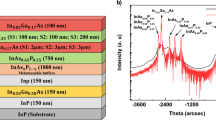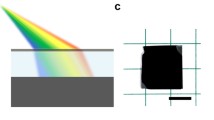Abstract
This work reports on the prospect of using photonic crystal resonances to improve the performance of Leonardo DRS’s Hg1−xCdxTe high-density vertically integrated photodiodes. Close examination of Leonardo DRS’s unique photodiode architecture reveals that it is a photonic crystal by its very construction. As a result, by carefully tailoring the lattice parameters, it is possible to take advantage of guided-mode resonances to improve the performance in very thin film arrays. Of particular emphasis in this work is using such resonances to bolster the performance in thin-film arrays with a material cutoff in the longwave infrared. We begin the paper by describing guided-mode resonances and the benefits they afford. We continue by modeling both simplified and realistic high-density vertically integrated photodiodes using the finite-difference time-domain method. We present one structure with a longwave infrared material cutoff that, due to the presence of a guided-mode resonance, leads to near-perfect transmission into the Hg1−xCdxTe, even in the absence of an anti-reflective coating. Additionally, this same structure absorbs nearly 88% of the incident light even though the Hg1−xCdxTe material is only 1.0 µm thick. Following this theoretical study, we fabricated test structures and performed Fourier-transform infrared spectroscopy measurements. The measurements clearly revealed the presence of guided-mode resonances. Moreover, the measurements agree well with our modeling. Further modeling of the same structures suggests nearly 89% of the incident longwave infrared light can theoretically be absorbed near the presence of the guided-mode resonance. Being able to achieve similar quantum efficiencies in thinner longwave infrared materials would be a significant achievement, as the dark current should roughly decrease proportional to the volume of the absorber. Moreover, reducing our longwave infrared material thickness from nearly 6.0 µm to 1.0 µm has the added benefits of increasing material throughput and decreasing chamber downtime for material grown using molecular beam epitaxy.





Similar content being viewed by others
References
M. A. Kinch, Proc. SPIE 4369 (2001)
A.I. D’Souza, M.G. Stapelbroek, L. Dawson, P. Ely, C. Yoneyama, J. Reekstin, M.R. Skokan, M.A. Kinch, P.K. Liao, M.J. Ohlson, P.J. Ronci, T. Teherani, H.D. Shih, and J. Robinson, Proc. SPIE 6206, 62062H (2006).
M.A. Kinch and K. Electron, Mater. 39, 1043 (2010).
R.L. Strong, M.A. Kinch, and J.M. Armstrong, J. Electron. Mater. 42, 3103 (2013).
M. A. Kinch, State-of-the-Art Infrared Detector Technology, SPIE, ISBN 9781628412895 (2014).
C. Schaake, R. Strong, M.A. Kinch, F. Harris, L. Robertson, J. Zhao, and F. Aqariden, J. Electron. Mater. 44, 3102 (2015).
P.D. Anderson, J.D. Beck, W. Sullivan III., C. Schaake, J. McCurdy, M. Skokan, P. Mitra, and X. Sun, J. Electron. Mater. 51, 6803 (2022).
J.D. Joannopoulos, S.G. Johnson, J.N. Winn, and R.D. Meade, Photonic Crystals: Molding the Flow of Light, 2nd edn. (Princeton: Princeton University Press, 2008).
P.R. Villeneuve, S. Fan, S.G. Johnson, J.D. Joannopoulos, and I.E.E. Proc, J Optoelectron. 145, 384 (1998).
M. Boroditsky, R. Vrijen, T.F. Krauss, R. Coccioli, R. Bhat, and E. Yablonovitch, J. Lightwave Technol. 17, 2096 (1999).
S. Fan and J.D. Joannopoulos, Phys. Rev. B 65, 235112 (2002).
C. Lin, L.J. Martinez, and M.L. Povinelli, J. Vac. Sci. Techol. B 31, 050606 (2013).
P.D. Anderson, C. Lin, and M.L. Povinelli, Appl. Phys. A. 117, 1879 (2014).
B.E.A. Saleh and M.C. Teich, Fundamentals of Photonics (London: Wiley, 1991).
A. Chutinan and S. John, Phys. Rev. A 78, 023825 (2008).
C. Lin and M.L. Povinelli, Opt. Express 17, 19371 (2009).
V.E. Ferry, M.A. Verschuuren, M.C. Lare, R.E.I. Schropp, H.A. Atwater, and A. Polman, Nano Lett. 11, 4239 (2011).
C. Lin, L.J. Martínez, and M.L. Povinelli, Opt. Express 21, A872 (2013).
M. Yao, N. Huang, S. Cong, C.-Y. Chi, M.A. Seyedi, Y.-T. Ling, Y. Cao, M.L. Povinelli, P.D. Dapkus, and C. Zhou, Nano Lett. 14, 3293 (2014).
M. Yao, S. Cong, S. Arab, N. Huang, M.L. Povinelli, S.B. Cronin, P.D. Dapkus, and C. Zhou, Nano Lett. 15, 7217 (2015).
K.K. Choi, J. Sun, E.A. DeCuir, K.A. Oliver, and P. Wijewarnasuriya, Infrared Phys. Technol. 70, 153 (2015).
P. Mitra, F.C. Case, J.H. McCurdy, S.A. Zaidel, and L.T. Claiborne, Appl. Phys. Lett. 82, 3185 (2003).
P. Mitra, F.C. Case, and J.H. McCurdy, Proc. SPIE 5074, 726 (2003).
J. Schuser and E. Belotti, J. Electron. Mater. 43, 2808 (2014).
A.I. D’Souza, E. Robinson, A.C. DeCuir, D. Okerlund, T.J. de Lyon, H. Shariti, M. Roebuk, D. Yap, R.D. Rajavel, N. Dhar, P.S. Wijerwarnasuriya, and C. Grein, J. Electron. Mater. 41, 2671 (2012).
K. Smith, J. Wehner, R. Graham, J. Randolph, A. Ramirez, G. Venzor, K. Olsson, M. Vilela, and E. Smith, Proc. SPIE 8353, 83532R (2012).
K. Sakoda, Optical Properties of Photonic Crystals (Berlin: Springer, 2005).
P. Capper, Properties of Cadmium-Based Compounds, ISBN: 0852968809 (1994)
E.D. Palik, Handbook of Optical Constants, ISBN: 978-0-12-54415-6 (1997)
Author information
Authors and Affiliations
Corresponding author
Ethics declarations
Conflict of interest
The authors declare that they have no conflict of interest.
Additional information
Publisher's Note
Springer Nature remains neutral with regard to jurisdictional claims in published maps and institutional affiliations.
Rights and permissions
Springer Nature or its licensor (e.g. a society or other partner) holds exclusive rights to this article under a publishing agreement with the author(s) or other rightsholder(s); author self-archiving of the accepted manuscript version of this article is solely governed by the terms of such publishing agreement and applicable law.
About this article
Cite this article
Anderson, P.D., Wilks, J., Armstrong, J.M. et al. Improving HDVIP Performance Using Photonic Crystal Resonances. J. Electron. Mater. 52, 7031–7037 (2023). https://doi.org/10.1007/s11664-023-10537-0
Received:
Accepted:
Published:
Issue Date:
DOI: https://doi.org/10.1007/s11664-023-10537-0




